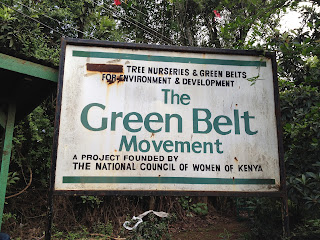As our driver, George, told us, the Maasai legend is that the Ngong Hills are the knuckles of a giant who tripped and was eaten alive by termites who left his knuckles behind. I hope George corrects me if that's incorrect, but that's what I remember hearing. After hearing that Ngong is the Maasai work for knuckles you can never look at them without thinking that they are in fact giant knuckles.
The trip started with a long drive to hills and a lot of money being paid to hike them. Because you can't just hike the Ngong Hills, you have to hire 2 guards to hike with you because there are a lot of violent and non-violent crimes committed about 3 hills in against hikers. The first 2-3 hills are just fine, but it's a good precautionary measure to take.
We drove up most of the first hill and words cannot explain how terrified I was; it felt like we were driving up the steep hills of San Francisco if they were taller, unpaved, and filled with goats and cows.
The hike was quite enjoyable and we all got to spend some great quality time together. The armed guards had M-16s but were quite friendly; some would say overly friendly. I'm pretty sure one of them asked out one of my fellow students.
The drive back down was as scary as the drive up. And we were stopped by fornicating goats in the middle of the road. When I told our other driver Joshua about the goats he said that they must've been in college.
The trip started with a long drive to hills and a lot of money being paid to hike them. Because you can't just hike the Ngong Hills, you have to hire 2 guards to hike with you because there are a lot of violent and non-violent crimes committed about 3 hills in against hikers. The first 2-3 hills are just fine, but it's a good precautionary measure to take.
We drove up most of the first hill and words cannot explain how terrified I was; it felt like we were driving up the steep hills of San Francisco if they were taller, unpaved, and filled with goats and cows.
The hike was quite enjoyable and we all got to spend some great quality time together. The armed guards had M-16s but were quite friendly; some would say overly friendly. I'm pretty sure one of them asked out one of my fellow students.
The drive back down was as scary as the drive up. And we were stopped by fornicating goats in the middle of the road. When I told our other driver Joshua about the goats he said that they must've been in college.





















